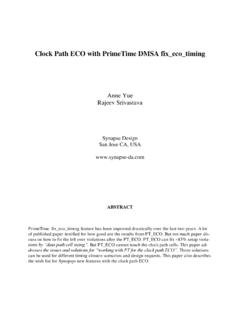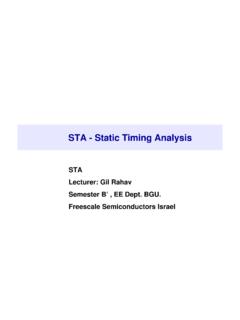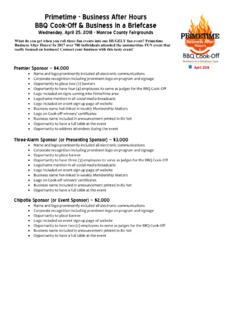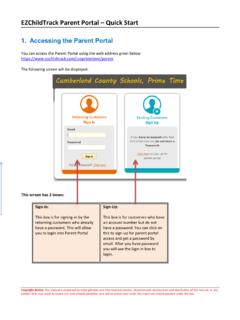Transcription of Consistent Timing Constraints with PrimeTime - Trilobyte
1 Consistent Timing Constraints with PrimeTimeSteve GolsonTrilobyte Systems388 Stearns StreetCarlisle MA 01741 Phone: + : implementation tools are usuallytiming-driven. They requiretiming Constraints forreliable, repeatable, and successful operation. Generating and verifying these Constraints is afamiliar yet sometimes tedious task for the physical implementation introduce the idea ofconsistent Timing Constraints and show how PrimeTime can be used tocreate and manage Timing constraint files needed for all other implementation tools, fromsynthesis to place-and-route to final chip San Jose 20092 Consistent Timing Constraints with IntroductionPhysical implementationmeans transforming an abstract RTL description of an integrated circuitinto a physically-realizable representation of the same circuit.
2 The primary rule for physicalimplementation engineers and their tools isDo not change the functionality. We go to greatlengths to maintain and verify the functionality of our second rule isMeet the specified Timing Constraints . These Constraints are defined in thedatasheet orspecification for the design, in tabular and graphical form. But how are these constraintstranslated into a format usable by physical implementation tools?This paper will delve into the problem of constraint generation for physical implementation introduce the concept ofconsistent Timing Constraints and discuss why this is criticallyimportant. We will outline a methodology relying on PrimeTime to generate and manage timingconstraints, and to guarantee the consistency of your Constraints , across all stages of the flow andall levels of Problems: Management and ConsistencyMany physical implementation tools are Timing driven.
3 A representative flow might include thefollowing steps (not necessarily in this order), each of which requires Timing Constraints forproper operation:automatic test pattern generation (ATPG)cell placementclock tree synthesis (CTS)design-for-manufacturing/design-for -yield (DFM/DFY) toolsdetail routerfloorplanninggate-level power analysisglobal routerRTL power analysisscan insertionstatic Timing analysissynthesis from RTL to gate-level netlistvoltage drop analysisThese Timing driven tools must havecorrect andcomplete means theconstraints used by the tool agree with the chip means you haven t left anythingout all Timing paths have a you1might ask, what s the big deal? Just create a file, the SDC file , edit it by hand, and feedit to all the Or your : Management and ConsistencySNUG San Jose 20093 Consistent Timing Constraints with PrimeTimeUnfortunately this doesn t work, due to differences amongst the tools:File formats Although most tools can use Synopsys Design Constraints (SDC) format [1], someuse Tcl scripts (not the same as SDC), and a few require custom New commands are periodically added to the SDC spec.
4 Your various tools might ormight not support the latest status As the design proceeds through the flow, the Timing Constraints change. Forexample, prior to clock tree insertion the clocks are modeled as ideal nets, with specified networklatency and uncertainty to model skew. After CTS the clocks can be propagated and theuncertainty is removed. Another example: scan clocks and I/Os must be constrained, but onlyafter scan insertion. Another example: synthesis Timing Constraints cannot use library-specific pinnames. Another example: synthesis Constraints may be more conservative than signoff Constraints (overconstrained synthesis).Features Multi-corner multi-mode (MCMM) is the big new feature for implementation andanalysis tools.
5 Many tools do not have this capability : Management and ConsistencySNUG San Jose 20094 Consistent Timing Constraints with PrimeTimeFigure 1 shows a portion of a typical 1. Typical flowDefine: ConsistencySNUG San Jose 20095 Consistent Timing Constraints with PrimeTimeIn summary, we have many tools used at various stages of the physical implementation flow. Eachtool may require its own unique Timing constraint file(s).Problem #1: How shall wemanage this multiplicity of files?Problem #2: How can we make sure that each tool in turn is working on the same critical path?How do we ensureconsistency? Define: ConsistencyLet s consider the second problem. As the design proceeds along the flow, each Timing -driven toolin turn uses its particular Constraints and internal Timing engine.
6 We ve already shown that theconstraint files will most likely not beidentical. However the Timing Constraints must example, after synthesis completes, run a Timing report showing the critical paths in eachclock group (path group). Now, moving along your flow, read the same netlist into the placementtool, and apply (possibly different!) Timing Constraints . Prior to doing anything with the placer,run a Timing report. Compare with the synthesizer Timing report. Do you see the same criticalpaths? Do you get the same slack?This is important because we want every tool to be optimizing the design toward the same defineconsistency as follows: Timing -driven tools haveconsistent Timing Constraints if, given the same netlist,they identify the same critical path for a given path is a more practical definition.
7 Consider Timing -driven tools A and B. We say they haveconsistent Timing Constraints if for the same netlist1. For tool A, for each path group, report the critical Now in tool B, report the identical path (startpoint, endpoint, through points, clocks).3. Tool B path must have same Constraints ( , clock period, clock latency, multicycle path,input/output delay).4. Tool B must report the same converse must also be true (swap A and B).Note you will have small Timing differences due to different Timing engines in the tools! Thisdifference is hard to quantify; you must learn from experience on your particular the differences are no more than a few percent of the total delay on the path. So let smodify our definition to read4.
8 Tool B must report the same slack, within some reasonable #2: Use PrimeTime throughout the flowSNUG San Jose 20096 Consistent Timing Constraints with PrimeTimeNote it s possible for some clock groups to be only in one tool. This depends on the multi-clock,multi-corner, multi-mode capabilities of the this only works for tools adjacent to each other in the flow. As the design progresses downthe flow, the critical path and timings will most likely Solution #2: Use PrimeTime throughout the flowPrimeTime is normally used as a signoff tool, at the end of the flow. However your PrimeTimesignoff Tcl scripts can be easily modified so they can be used at any point earlier in the flow. Thisallows us to use PrimeTime as the reference tool, and prove that each implementation tool in theflow isconsistent with the signoff we are not looking at the final Timing reports from the signoff netlist rather we are runningPrimeTime on the intermediate is a straightforward task to modify signoff PrimeTime Tcl Constraints such that they can be usedat other points in the flow.
9 There are a small number of switches required:FIX_HFN(true or false): Early in the flow it is common for the synthesis tool to treat high fanoutnets (HFNs) as ideal nets. The place&route tool is then used to build topologically-aware buffertrees. Also need integer variableHFN_FANOUT_THRESHOLD such that any net with fanoutgreater than this is given ideal (specified or not): If this file (or files) are specified then parasitics areannotated onto the design. Otherwise a wireload model is used. Note this could be estimatedparasitics from Design Compiler Topographical or actual post-route extracted (true or false): Prior to clock tree synthesis (CTS) all clock nets aretreated as ideal nets with specified network latency, and additional uncertainty is added to modelclock skew.
10 After CTS the clocks are propagated with actual (true or false): Crosstalk analysis is only needed for final signoff, status(automatically determined): As mentioned before, there may be constraint changesdue to netlist status, for example whether or not scan has been inserted. Rather than add additionalswitches, we can often determine the netlist status using various PrimeTime commands. Forexample it is straightforward to determine whether or not the scan clock port exists? and does ithave a net attached to it? If not we assume scan is not inserted, thus scan clocks and associatedconstraints may be code examples using these switches are given in the Appendix starting on page #1: Use PrimeTime to generate all needed constraint filesSNUG San Jose 20097 Consistent Timing Constraints with Solution #1: Use PrimeTime to generate all needed constraint filesNow the way is clear to solve the first problem.









